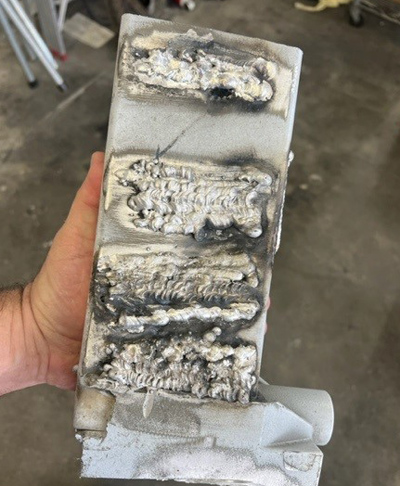Recently, I got a call from Mike Schaffer, collision manager at Selman Collision Center, a GM aluminum-certified shop in Orange, CA, needing help welding an aluminum body Cadillac CT6. He thought his welder was the problem. I told him I could be there in two days, and he should consider a review course on aluminum welding at the same time.
When I arrived, the first thing he showed me was the front rail section that was removed from the vehicle. It had practice welds on one side, and they were horrible. I asked Schaffer if they had welded on the new part and he said not yet.
I checked the welder, and it was set for 5554 wire, 1.2 mm diameter and pulsed. I checked the tension on the rollers and it was right on. I took out a couple of 5 Series coupons and welded a fillet/overlap joint. Their Pro Spot SP5-DP worked great.
I knew what the problem was instantly, but before I explain, let me give you the scenario.
The end cap was cast aluminum (Series 4), the rail was extrusion (Series 7) and the wire was 5554 (Series 5).
The major alloying element in Series 4 is silicon, Series 5 is magnesium, Series 6 is a combination of silicon and magnesium, and Series 7 is alloyed with zinc.
What are the four major welding wire numbers found in most body shops? 4043, 4145, 5554 and 5356.
The rule of thumb is this: your welding wire has to have the same major alloying element(s) as what is in the base metal. Note: Series 5 wire is recommended for Series 7 aluminum.
Remember, Series 6 aluminum has both magnesium and silicon. You can use Series 4 welding wire (silicon) and Series 5 wire (magnesium) on Series 6 aluminum. Series 4 wire is weaker and needs less amperage to weld, making it easier to weld thinner aluminum, such as a crack in a 1 mm fender.
Series 5 wire will weld Series 5 aluminum, but Series 4 wire will not. There is very little to no penetration of Series 4 wire into Series 5 aluminum.
The article title is advice I also need to take. I have been teaching aluminum welding for I-CAR for nearly two decades. When I first started, my instructor said the test had to be conducted with Series 5 (5356) wire, not Series 4 (4043), because the Series 4 wire will not penetrate Series 5 aluminum. I was also told Series 5 wire would not work on Series 4 cast aluminum. As I previously wrote, my rule of thumb is not entirely correct.
To write this article, I read several articles on aluminum welding. Series 5 wire can be used on Series 4 cast aluminum parts. 5554 wire is stronger than 4043, but tends to produce porosity and cracks when used to weld aluminum castings. 4043 is better for castings because the silicon content makes it a closer match for most aluminum castings. Furthermore, some OEMs recommend Series 4 wire for welding to cast aluminum.
I want to change my rule of thumb to: “Your welding wire has to have the same major alloying element(s) as what is in the base metal when welding Series 5 and 6 wire. When welding Series 4 and 7, refer to OEM procedures.”
I want to move on to OEM procedures.
I am always stressing first and foremost, print out the repair procedures for the repair task, including the library. Schaffer sent three documents: Aluminum, Structural Identification and Front Rail Replacement (Non-Hybrid). The repair and replacement procedures said the new cast rail end is welded to the extruded rail---the only information on the procedure. To learn the correct wire, you have to print out the other two documents, aluminum and the part material and part description.
The rail end cap was cast and the rail end cap was extruded (Series 7) and 5554 wire was called out. I knew Series 7 parts are used on today’s vehicles, such as bumper reinforcement and intrusion beams, but I wasn’t familiar with it being used or welded before reading the info from GM.
Aluminum oxide is a high temperature compound that forms on bare aluminum in presence on water and oxygen. It needs to be removed during and/or prior to welding. If it is not cleaned, the aluminum oxide will sink into the molten metal and form inclusions with weld. This will lead to porosities and/or cracks.
Galvanic corrosion refers to corrosion damage that occurs when electrochemically dissimilar metals (bare steel and bare aluminum) come in contact with each other in the presence of moisture and oxygen. The aluminum will corrode and there is no way to stop it.
The improper use of steel cleaning products, such as steel wool or a steel wire brush on aluminum or magnesium, can force small pieces of steel into the metal being cleaned, causing corrosion. Stainless steel is known for its high resistance to corrosion because of its high chromium content combined with nickel. It also has very low carbon content, whereas mild steel is higher in carbon content, which facilitates galvanic corrosion. After using a stainless steel brush to clean the aluminum, wipe with acetone, 99% isopropyl alcohol or a good wax and grease remover. Do not use lacquer thinner.










Abby Andrews